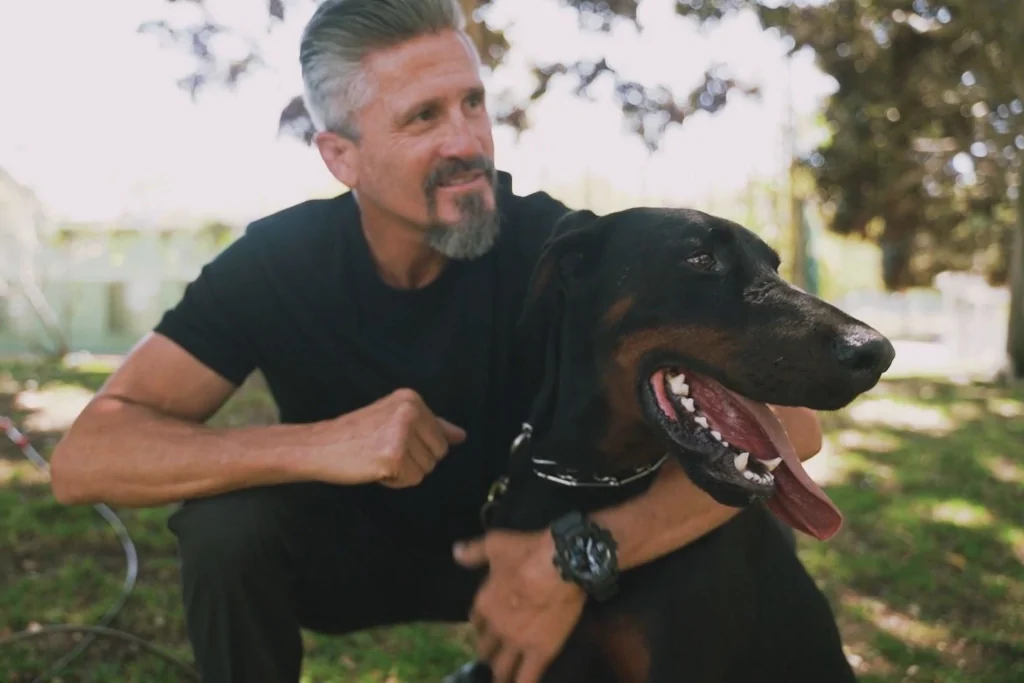Lost in a sea of barks and whimpers, you might have wondered: “Can I communicate better with my dog? Could a ‘dog whisperer’ help, and are they for real?”
They claim to interpret canine body language and signals to establish a stronger connection between humans and their furry friends.
But as with many things that sound too good to be true, it’s vital to look beyond the surface. While there’s no denying the allure of a quick fix, training and understanding your dog involves more than whispers.

Dog Whisperers: Separating Fact From Fiction
So, you’ve seen the TV shows and the dramatic transformations that make ‘dog whispering’ look like magic.
It’s natural to feel intrigued. But let’s consider the reality, peeling back the layers of these seemingly miraculous feats.
Dog whisperers often employ a mix of intuition and observation of canine behavior. They claim to understand dogs at an almost psychic level, to ‘speak’ their language. But before you find yourself reaching for your phone to hire a dog whisperer, let’s dive into what’s really happening behind those alluring claims.
It’s crucial to separate showmanship from actual effective communication techniques, and that’s exactly what we’re going to do in this blog post.
What Do Dog Whisperers Claim to Do?
The dog whispering philosophy primarily revolves around the notion of understanding and speaking the ‘language’ of dogs.
Dog whisperers claim they can bridge the communication gap between humans and canines by interpreting subtle signals and behaviors that average pet owners might miss. They often talk about establishing an “alpha” role to guide dogs toward better behavior.
They typically employ a variety of techniques from direct eye contact, specific body postures, vocal inflections, and even touch to get dogs to respond in a particular way.
They advocate for a more ‘instinctual’ approach, often citing how dogs behave and interact in packs in the wild. While these methods may sound intriguing, it’s critical to understand what’s valid and what’s not from a scientific perspective.
Examining the Science Behind Their Methods
When it comes to dog whispering, we must dissect the facts from the fiction and understand what science has to say about these methods.
Contrary to the belief of establishing an “alpha” role, most modern behavioral experts advocate against dominance-based training. Scientific research has shown that dogs don’t operate within a hierarchical structure when interacting with humans as they do in the wild with other dogs.
Therefore, trying to be an ‘alpha’ may not yield the results you’re looking for and could potentially harm your relationship with your pet.
Moreover, behavioral science suggests that positive reinforcement methods, where good behavior is rewarded, are much more effective and foster a stronger, healthier bond between dogs and their owners. These methods promote understanding and mutual trust, rather than instilling fear or asserting dominance.
As a dog trainer, my advice is to approach dog whispering with a critical eye. Always prioritize methods that are scientifically backed, and remember that building a relationship with your dog is a journey that goes beyond quick fixes. It’s a process filled with empathy, understanding, and patience.
What the Experts Say About Dog Whisperers
In the professional dog training community, opinions on dog whispering are mixed.
While some applaud the natural approach, many experts express reservations. They caution that misinterpretation of dog behaviors and misguided attempts to assert dominance can inadvertently lead to more issues.
Instead, they advise using techniques based on scientific research and evidence-based practices.
As a dog trainer myself, I align with this viewpoint. We must remember that every dog is an individual, and what works for one might not work for another. An all-purpose approach, like some aspects of dog whispering, may not be the best fit for every dog.
Evidence-Based Training Alternatives
Rather than relying solely on dog whispering, consider proven, research-backed alternatives.
Positive reinforcement training is widely supported by experts and has been shown to foster a better relationship between dogs and their owners. This method focuses on rewarding desired behaviors, which encourages your furry friend to repeat them.
One popular technique is clicker training, a form of positive reinforcement that uses a clicker device to mark the exact moment a dog performs a desirable behavior. Once the dog associates the sound with a reward, the clicker becomes a powerful tool for shaping behavior.
Similarly, using treats effectively can be a great motivator for dogs. A high-value treat, one that your dog doesn’t get often, can be especially effective when training.
However, it’s important to balance rewards with the dog’s overall health. If your dog has a tendency to gain weight, make sure the treat size is appropriate, and consider healthier options like lean proteins or vegetables.
If your dog isn’t food-driven, toys or praise can also work as rewards.
As a dog trainer, my mantra is patience and consistency. Training is not a one-time event, but a consistent effort. Remember to maintain a positive attitude, and most importantly, enjoy the process. It’s a special time for you and your dog to bond, learn, and grow together.

Making the Right Choice for Your Dog’s Training
Choosing the right training approach for your dog is as personal as selecting a diet or even a vet.
It’s an opportunity to shape your relationship with your furry friend, and the process should reflect your values and understanding of your dog’s individual needs.
I recall my own journey into becoming a dog trainer… it all started with my dog, Sam. Despite being the most energetic and playful puppy, Sam struggled with anxiety. Navigating through different training methods and finally seeing positive changes in him was a rewarding process, reinforcing my belief that every dog requires a unique approach.
Remember, the goal is to strengthen your bond with your dog and make both of you happier in the process.
As you make this important decision, keep an open mind, be patient, and remain consistent in your efforts. Above all, respect and understand your dog’s individuality.
If you’re ever uncertain, seeking help from a professional trainer who uses evidence-based methods is an investment worth considering.
FAQs
Can I become a dog whisperer myself?
Learning dog whispering techniques is possible for anyone with dedication and patience. It’s a process that involves in-depth study and consistent practice, and often, guidance from a professional is beneficial.
How long does it typically take for a dog whisperer to train a dog?
A dog whisperer may achieve minor behavioral changes in a few weeks. However, for substantial progress, the training period could extend up to several months, depending on the dog’s behavior and specific issues being addressed.
Are dog whisperer methods suitable for all dog breeds and ages?
Dog whispering techniques can be tailored to suit all dog breeds and ages, but it’s crucial to consider each dog’s individual needs and behaviors.
How much does it cost to hire a dog whisperer?
Hiring a dog whisperer might cost anywhere from $50 to several hundred per session. The pricing largely depends on the whisperer’s expertise and location.
Alex, a passionate animal lover, has experience in training and understanding animal behavior. As a proud pet parent to two dogs and three cats, he founded AnimalReport.net to share insights from animal experts and expand his knowledge of the animal kingdom.





Please let me know if you’re looking for a author for your blog. You have some really great articles and I believe I would be a good asset. If you ever want to take some of the load off, I’d really like to write some material for your blog in exchange for a link back to mine. Please blast me an email if interested. Thank you!
Sure thing!